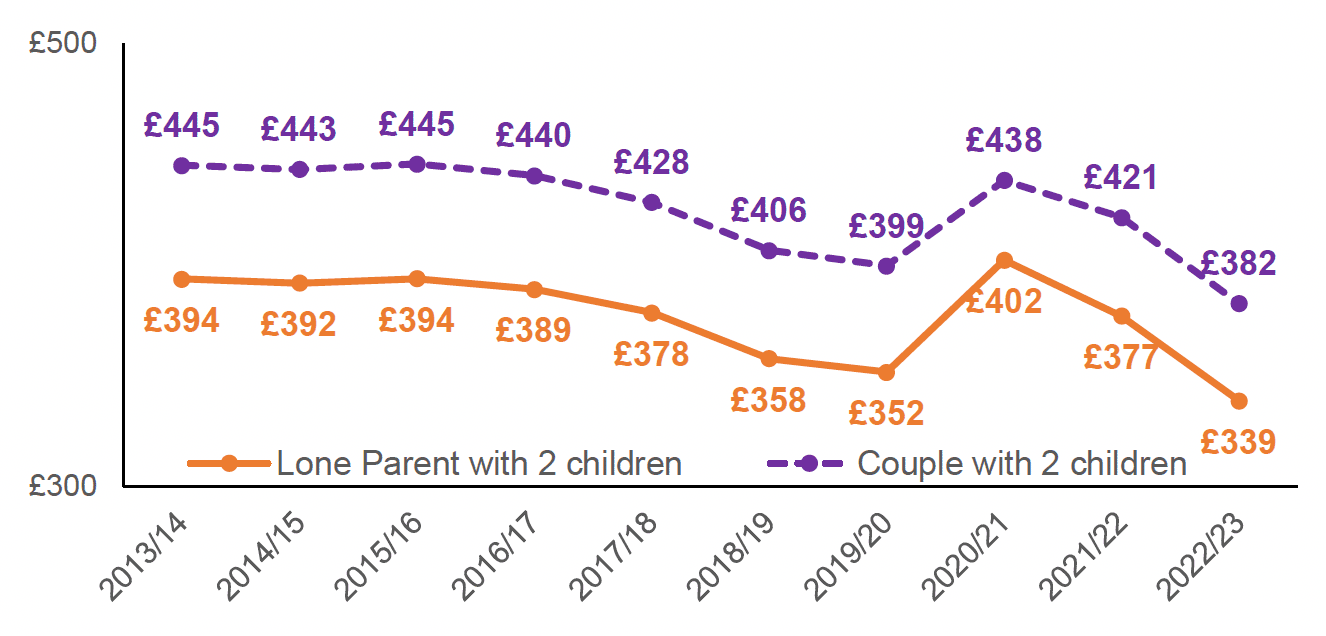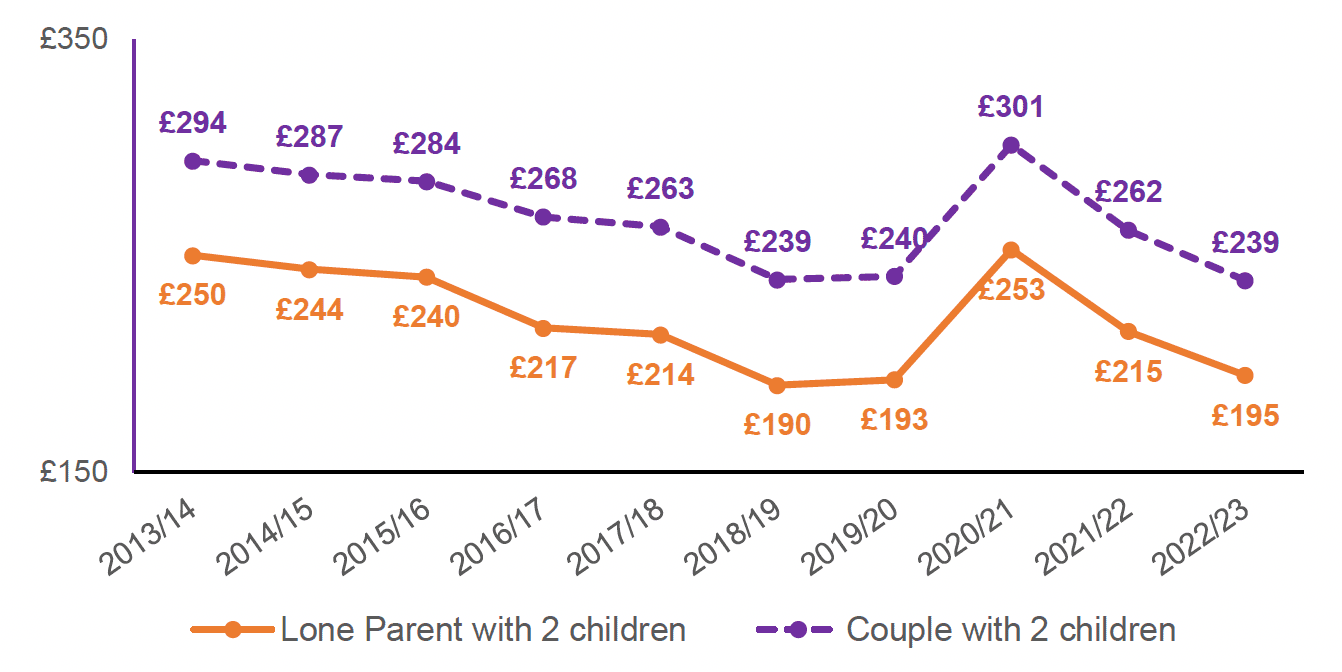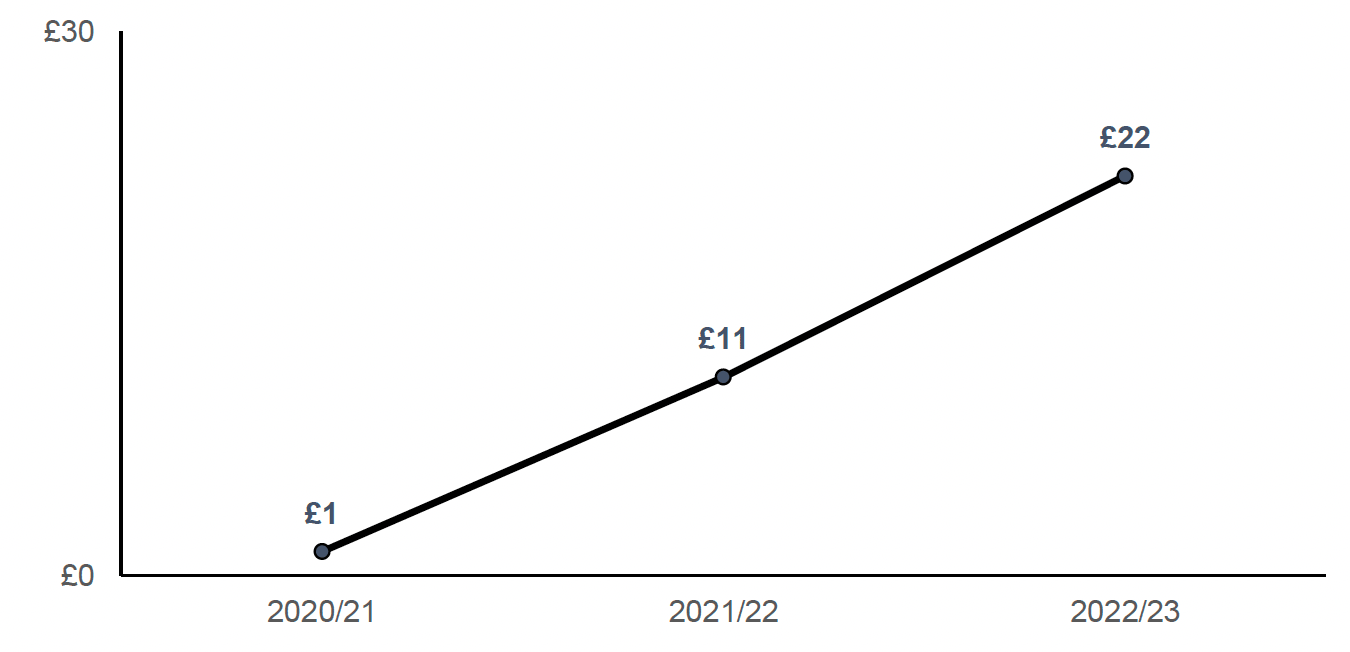Tackling child poverty delivery plan - progress report 2022-23: annex a - measurement framework
Child poverty measurement framework with the latest data on the drivers of child poverty. The indicators in the child poverty measurement framework are intended to monitor these drivers of poverty.
Driver: Income from Social Security or Benefits in Kind
Indicator 22: Reach of benefits
Proportion of children, in Scotland, who are eligible for Universal Credit. Full Universal Credit roll-out is assumed in the modelling which is based on three year pooled data from 2017-20. This is a new indicator from 2023.
Data from Family Resources Survey with micro simulation using UK MOD.

How this indicator relates to the child poverty targets:
Relative poverty √
Absolute poverty √
Low income + material deprivation √
Persistent poverty √
The indicator measures the proportion of children who are eligible for Universal Credit. The calculation is done using a microsimulation model. This indicator requires careful interpretation, as a fall could be a result of positive change, such as households with children having more money, and therefore being above the Universal Credit threshold. It could also, however, be as a result of a negative influence such as eligibility becoming tighter, for example through policy changes such as benefit amounts being frozen.
Indicator 23: Value of out-of-work benefits
Real terms value (£/per week in 2022-23 prices) of reserved social security entitlement (Universal Credit including housing element) for out-of-work lone parent/couple households with two children in Stirling. This is a new indicator from 2023.
Source: DWP benefit rates

How this indicator relates to the child poverty targets:
Relative poverty √
Absolute poverty √
Low income + material deprivation √
Persistent poverty √
Social security payments have a direct impact on poverty by providing or supplementing household income. The difference between lone parents and couples throughout the series is largely due to the difference in the amount of the standard allowance of UC depending on whether it is for a single person or a couple.
Notes on the calculation of this indicator
The real value of Universal Credit for these representative households has been estimated without the childcare element. The judgement to exclude it was made because:
- Take-up of the childcare element is estimated to be low: overall, around 11% of households on UC in Scotland are claiming for a childcare element as part of their UC claim;
- And, among those who do take up the childcare element as part of their UC claim, the majority of recipients are claiming amounts substantially below the maximum.
The Spring 2023 budget amended this policy to allow the childcare element to be paid up front, instead of arrears. This could increase take-up and we will therefore keep this decision under review going forward.
The real terms value (£/per month in 2022-23 prices) of UC was calculated using the CPI inflation rate, year-on-year to September 2022, as the previous year's September rate of inflation is used for uprating UC amounts. No taxes or legacy benefits were included in the real terms value calculations – they are based only on income from Universal credit. The benefit cap treatment applied within the calculator limits the amount of UC a household can claim for their circumstances. The cap was frozen from 2016-17 to 202-23. A weighted average was used to incorporate any relevant policy changes that occurred in-year into the UC income calculation.
Indicator 24: Value of in-work benefits
Real terms value (£/per week in 2022-23 prices) of reserved social security entitlement (Universal Credit including the housing element) for a lone parent working full-time / couple with one working full-time and one not in paid employment, on minimum wage, with two children in Stirling. This is a new indicator from 2023.
Source: DWP benefit rates

How this indicator relates to the child poverty targets:
Relative poverty √
Absolute poverty √
Low income + material deprivation √
Persistent poverty √
Social security payments have a direct impact on poverty by providing or supplementing household income. The difference between lone parents and couples throughout the series is largely due to the difference in the amount of the standard allowance of UC depending on whether it is for a single person or a couple.
Notes on the calculation of this indicator
The real value of Universal Credit for these representative households has been estimated without the childcare element. The judgement to exclude it was made because:
- Take-up of the childcare element is estimated to be low: overall, around 11% of households on UC in Scotland are claiming for a childcare element as part of their UC claim;
- And, among those who do take up the childcare element as part of their UC claim, the majority of recipients are claiming amounts substantially below the maximum.
The Spring 2023 budget amended this policy to allow the childcare element to be paid up front, instead of in arrears. This could increase take-up and we will therefore keep this decision under review going forward.
The real terms value (£/per month in 2022-23 prices) of UC was calculated using the CPI inflation rate, for the financial year. The ONS estimate of full time hours, and the minimum wage from the UK Government were used to provide an earnings figure for the purpose of calculating the UC benefit reduction resulting from in work activity. No taxes or legacy benefits were included in the real terms value calculations – they are based on income from Universal credit or/and earnings. The benefit cap treatment applied within the calculator limits the amount of UC a household can claim for their circumstances. The cap was frozen from 2016-17 to 2022-23. A weighted average was used to incorporate any relevant policy changes that occurred in-year into the UC income calculation.
Indicator 25: Value of Scottish Child Payment
Real terms value (£/per week in 2022-23 prices) of devolved social security entitlement (Scottish Child Payment) per child. This is a new indicator from 2023.
Source: Scottish Government benefit rates

How this indicator relates to the child poverty targets:
Relative poverty √
Absolute poverty √
Low income + material deprivation √
Persistent poverty √
Social security payments have a direct impact on poverty by providing or supplementing household income.
Notes on the calculation of this indicator
The real value of Scottish Child Payment has been estimated (£/per month in 2022-23 prices) using the CPI inflation rate for the financial year. A weighted average was used to incorporate any relevant policy changes such as increase in the financial value of payments that occurred in-year into the real value SCP calculation.
Indicator 26: Benefit take-up: Scottish Child Payment
Estimated take-up (percentage of those entitled to benefit who receive it) of Scottish Child Payment (2021-2022). This is a new indicator from 2023. This indicator will be updated as a time series in the future.
Source: Social Security Scotland

How this indicator relates to the child poverty targets:
Relative poverty √
Absolute poverty √
Low income + material deprivation √
Persistent poverty √
Social security payments have a direct impact on poverty by providing or supplementing household income. Take-up measures whether the benefit is being paid to those intended.
Contact
Email: TCPU@gov.scot
There is a problem
Thanks for your feedback